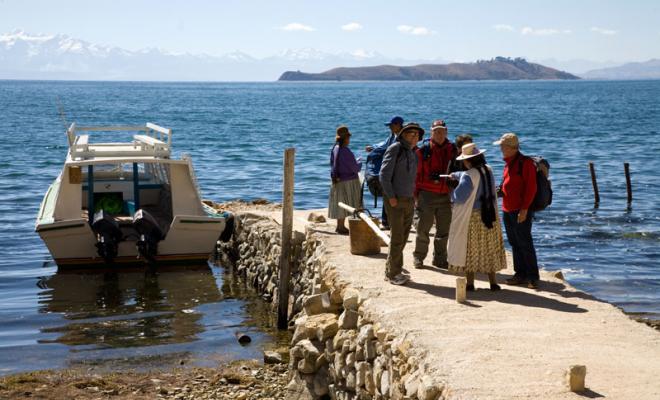Can tourism contribute to achieving gender equality and women’s empowerment in Bolivia?

Agnes Medinaceli of SDSN Bolivia highlights why women’s empowerment is a key concern for Bolivia’s tourism industry and new GLOW research to help ensure tourism is a sustainable and gender-inclusive engine of development for the country.
According to the UN World Tourism Organization, tourism has the potential to play a crucial role in fulfiling the 2030 Agenda, particularly the commitment to achieve gender equality and women’s empowerment, and the determination to leave no one behind.
At first glance, it seems that tourism in Bolivia is already proving to be an ally in the fight for gender equality. Before the pandemic, 76% of people employed in tourism sector were women, compared to 54% globally (see the figure below).
While it is positive that many women are engaged in Bolivian tourism – it is the quality of their work, not just the quantity, that counts. There are numerous challenges that can potentially undermine gender equality and women’s empowerment in this sector, if action is not taken.
Percentage of people employed in tourism who are women, 2018 (%)

Source: UNWTO (2021; page 10)
A word of caution from Thailand
Bolivia can learn a number of lessons from Thailand’s experience.
The history of tourism in Thailand dates back to the Vietnam War, where entertainment businessmen in Bangkok made profits from the frequent arrivals of the US military. When the war ended, Thailand decided to rebuild its economy by promoting the development of mass tourism, following the recommendations of the World Bank. However, because Thailand was a long and expensive flight from most countries with populations that enjoyed paid holidays, it did not succeed in attracting families, but rather men traveling alone.
As a consequence, sex tourism that was exploitative to local women burgeoned in the country and today very little has changed.
The combination of high levels of corruption, poverty and familial cultural expectations in this Asian country has allowed this exploitation to continue. The sex industry in Thailand contributes approximately 10–12% to the country’s overall GDP, but at what cost? Various organisations are trying to empower sex workers by giving them access to education and changing the narratives surrounding gender equality and shame. But as Narula points out, sex workers can’t feel or be empowered within a system beyond their control and where they are still vulnerable to sexually transmitted diseases, violence and other threats.
What actions can we take in Bolivia to avoid the worst scenarios?
Before the pandemic, the tourism sector in Bolivia employed 289,300 women, but data and research are scarce on the quality of women’s jobs in this sector. In an ideal world, promoting tourism in Bolivia would give more women decent jobs and thus empower them economically. However, as observed in Thailand, things can go wrong even when there are good intentions. Bolivia also suffers from corruption, poverty and sexism, so nothing ensures that promoting tourism may not end up exploiting Bolivian women in one way or another.
What can Bolivia do to avoid the worst scenarios and promote gender equality and women’s empowerment? The quick answer: study the different dimensions of both the positive and negative aspects of the Bolivian tourism industry to understand it better and promote the implementation of good practices.
Understanding empowerment
To start, we need to comprehend what empowerment means for the women in this industry and how it can be achieved. Empowerment has different definitions, but all of them focus on the analysis of power on oppressed groups. Kabeer defines power “as the capacity to make choices”, and empowerment the processes by which disempowered people gain this ability.
Under this framework, can Bolivian women who have a decent job in the tourism sector be or feel empowered if they can’t decide how their earnings will be used because their partners have the final word?
Understanding all dimensions of gender inequality
Moreover, we also need to study what gender inequality means for women working in the industry. Most of the time, we automatically tend to think of pay gaps and women’s labour force participation when gender inequality is discussed. But gender inequality involves other aspects. Hence, we need to broaden our views. For instance, we need to study the Bolivian ideologies that place women as inferior to men and create inequalities at work. As an example, more research about the micro-violence that women in the tourism sector suffer every day is needed, such as when they are asked to wear certain uncomfortable clothes.
In conclusion, tourism can play an essential role for gender equality. Still, we require more thorough research to understand various aspects of inequality, not only economic inequality, and the role they play within the tourism industry as well as Bolivian households.
The Bolivian Tourism Observatory (ORBITA) responds to this need to further understand how tourism can be more of a sustainable and gender-inclusive engine of development for Bolivia. ORBITA has been established as part of the project to serve as an information hub on tourism, gender and sustainable development. It build alliances to support the recovery and growth of the sector (particularly post-Covid 19), train small and medium tourism enterprises in new digital technologies and promote equal opportunities for women in the sector.
Learn more about this project here and access the newly-launched Observatory: http://orbita.bo/

